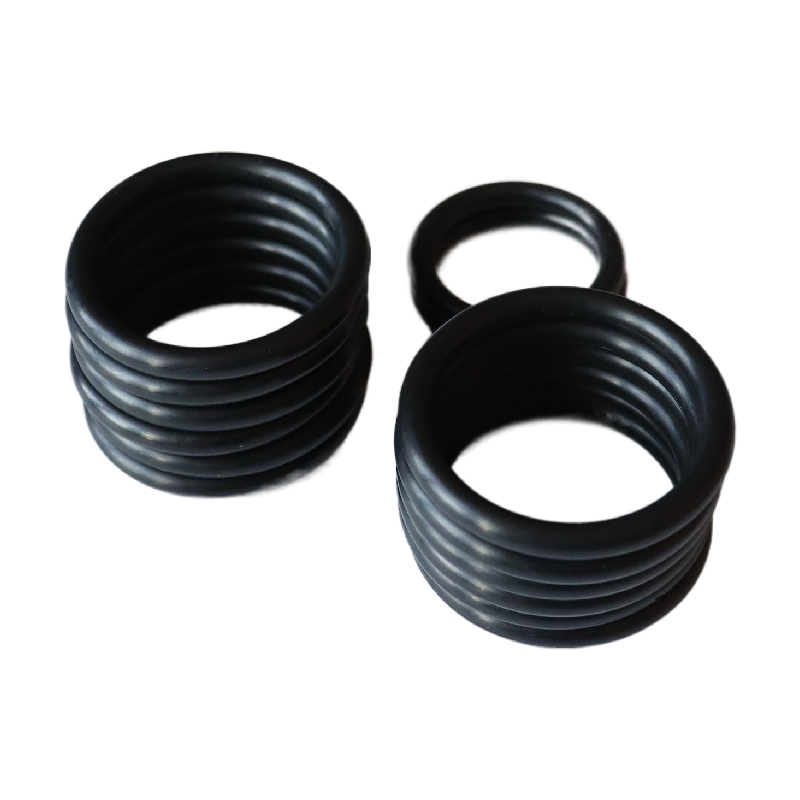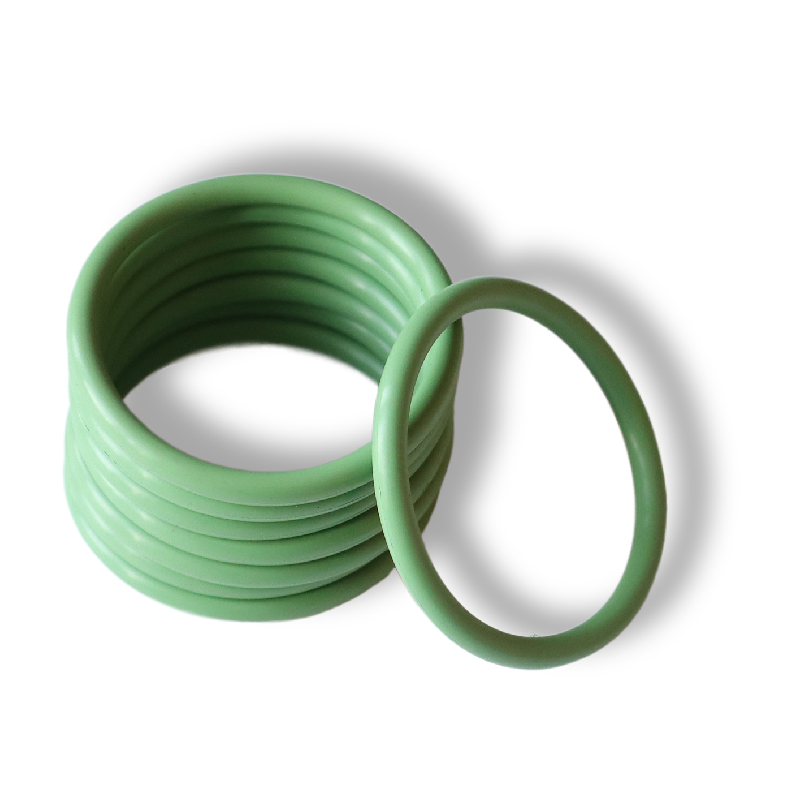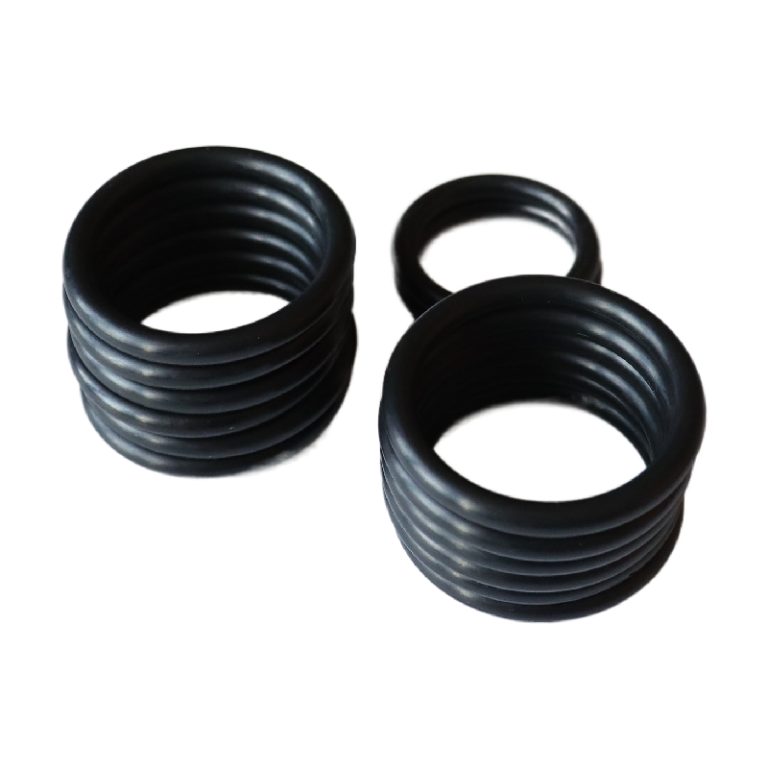O-ring types, materials, characteristics, use of the whole analysis
Rubber O-ring is a commonly used sealing element in industrial equipment, widely used in various types of mechanical equipment, to undertake the important task of preventing liquid or gas leakage. They have a simple structure, usually consisting of a circle of rubber material with a circular cross-section, shaped like the letter “O”, hence the name. Despite their simple design, O-Rings are able to provide excellent sealing results in extremely complex and variable operating environments. In this paper, we will elaborate on the types, materials, characteristics and uses of O-rings, and analyze the working principle of O-rings and their applications in different fields.
First, the basic overview of the O-ring

The role of the O-ring is to form a sealing surface through compression with the adjacent parts to prevent the leakage of gas, liquid or dust. Its working principle is based on the compression deformation characteristics, when the O-ring is compressed with the contact surface, its elastic restoring force will make the O-ring produce a close contact and form an effective sealing layer.The size, material and hardness of the O-ring can be selected according to the different environments in which they are used, to ensure that they can withstand the temperature, pressure and chemical mediums that may occur in the work, and other factors.
Second, the type of O-ring
The types of O-rings can be categorized in different ways according to the material, application type, cross-section size and so on. The following are the main ways of categorization:
- Classification according to material
O-rings made of different materials have different performance characteristics and are suitable for different working environments. Common O-ring materials include:
Nitrile rubber (NBR): It has excellent oil and fuel resistance and is commonly used in automobile, machinery and petrochemical industry. Its disadvantage is poor resistance to high temperature, generally applicable to -30 ° C to 100 ° C working environment.
Fluoroelastomer (FKM): has good high temperature resistance (can withstand more than 200°C) and excellent chemical resistance, suitable for aerospace, chemical equipment and other demanding sealing applications.
Silicone rubber (VMQ): excellent resistance to high and low temperatures (-60°C to +230°C), widely used in medical, food processing and electronic equipment.
Chloroprene rubber (CR): with good UV and ozone resistance, it is suitable for applications in outdoor environments, such as automotive seals and refrigeration systems.
Polyurethane (AU): with high abrasion and oil resistance, it is suitable for hydraulic systems and heavy duty working environments.
EPDM rubber (Ethylene Propylene Rubber): good resistance to high temperature, oxygen, ozone, acid, alkali and other chemicals, widely used in chemical, automotive, construction and other industries.
Natural Rubber (NR): has excellent elasticity and abrasion resistance and is suitable for low and normal temperature environments, but is less resistant to UV, ozone and high temperatures.
Chlorinated polyethylene rubber (CM): has good chemical resistance and UV resistance, suitable for chemical and environmental protection industries.
Fluorosilicone Rubber (FVMQ): combines the advantages of silicone rubber and fluoroelastomer, suitable for aerospace and high temperature chemical industries, with high temperature resistance and excellent chemical stability.
Polytetrafluoroethylene (PTFE): Extremely chemically inert, high temperature resistant and resistant to almost all chemical media, suitable for high temperature, high pressure and highly corrosive environments.
Ethylene propylene diene rubber (EPM/EPDM): strong chemical resistance and oxidation resistance, suitable for automotive, construction, fire protection and other industries, especially suitable for water pipes, gas supply equipment and chemical equipment seals.
Butyl rubber (IIR): especially suitable for gas sealing, with excellent gas isolation performance, commonly used in equipment with high gas tightness requirements.
Polyester rubber (Polyurethane): excellent abrasion resistance, oil resistance and high strength, suitable for hydraulic systems and heavy load environment.
Thermoplastic elastomer (TPE): combining the characteristics of rubber and plastic, environmentally friendly and easy to process, widely used in automobiles, home appliances and medical equipment.
- Classification by application type
According to the working condition of O-ring, it can be divided into:
Dynamic O-rings: used for dynamic sealing, such as piston sealing and shaft sealing in hydraulic systems. They require high wear resistance and self-lubricating properties.
- Categorized by cross-section size
O-Rings can be classified according to their cross-section size based on standardized regulations, such as ISO 3601, AS 568A, etc.. Different sizes can also be customized according to special requirements.
Third, the characteristics of O-ring
The excellent sealing properties of O-Rings have led to their wide application in many fields. Its key characteristics include:
- Sealing performance
The main function of O-ring is sealing, through compression with the matching surface to produce elastic restoring force, the formation of a tight sealing surface, to prevent the leakage of gas, liquid or dust. The sealing performance is closely related to the elasticity, compression and material selection of O-ring.
- Temperature resistance
O-ring temperature resistance depends on its material. For example, silicone rubber O-ring has excellent resistance to high and low temperatures, while the fluorine rubber is suitable for high temperature environment. O-ring selection needs to be based on the temperature changes in the working environment to make a reasonable choice.
- Chemical resistance
O-rings made of different materials have different chemical resistance. Fluorine rubber, PTFE, EPDM and other materials have excellent chemical resistance, suitable for chemical media and corrosive environment.
- Abrasion and aging resistance
For applications with high-frequency motion, the abrasion resistance of O-rings is particularly important. Polyurethane and polyester rubbers have excellent abrasion resistance. In addition, high-quality O-Ring materials are highly resistant to UV and ozone aging, ensuring a long service life.
- Elasticity
O-Rings need to be elastic enough to return to their original shape after compression and maintain a seal. Poorly elastic O-rings may result in poor sealing, affecting the normal operation of the equipment.
Fourth, the use of O-ring
O-rings are widely used in various fields, the following are some typical applications:
- Automobile industry
In the automotive industry, O-rings are widely used in the engine, hydraulic system, brake system, transmission system and other parts of the engine, for sealing oil lines, fuel lines, water pipes and gas pipes. Due to the large temperature changes in the automobile working environment, it is crucial to choose the right O-ring material. - Chemical industry
Chemical industry involves a large number of corrosive chemical media, O-rings are widely used in chemical reaction equipment, piping systems, pumps and valves, which can effectively prevent chemical leakage and ensure production safety. - Oil and gas industry
In the process of oil and gas extraction, O-rings are used in the sealing of drilling equipment, oil well pipelines, oil storage tanks and other equipment. Due to the high temperature and high pressure and complex chemical environment, it is necessary to choose O-rings that are resistant to high temperature and chemical media. - Medical and food industry
Medical equipment and food processing equipment need to meet strict hygiene standards, O-rings are usually made of silicone rubber and EPDM to ensure non-toxic, high temperature resistant and easy to clean. - Aerospace
In the aerospace field, O-rings are used in aircraft engines, hydraulic systems, spacecraft sealing components, which need to have high strength, high pressure resistance, high temperature resistance and other characteristics.
As a sealing element, rubber O-rings are widely used in various industries by virtue of their simple structure, strong sealing performance, wide range of applications and other advantages. Choosing the right O-ring material, size and hardness is the key to ensure the sealing effect and prolong the service life. Through correct installation, maintenance and regular replacement, the sealing performance of O-ring can be effectively improved to ensure the normal operation of the equipment.


